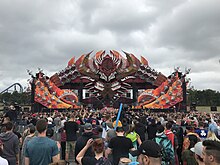

| Hardstyle | |
|---|---|

The Red stage at Defqon.1 in 2018, the world's biggest hardstyle festival
| |
| Stylistic origins |
|
| Cultural origins | Late 1990s–early 2000s, Netherlands, Italy, Belgium |
| Derivative forms | Big room hardstyle[1] |
| Other topics | |
|
| |
Hardstyle is an electronic dance genre that emerged in the late 1990s, with origins in the UK, the Netherlands, France, Belgium, Germany and Italy. Hardstyle mixes influences from techno, new beat and hardcore.
Early hardstyle was typically written at 140 BPM (beats per minute); however, modern hardstyle is faster, produced around 150 BPM. It consisted of overdriven and hard-sounding kick drums, often accompanied by an offbeat bass, known as a "reverse bass". As the genre grew, the production techniques and songwriting changed to be suited to a more commercial audience. Modern hardstyle can be recognized by its use of synthesizer melodies and distorted sounds, coupled with hardstyle's signature combination of percussion and bass. The genre is particularly known for its harmonic use of kickdrums. Due to the sustained nature of a hardstyle kick, producers are able to play basslines by using only the kick itself, which becomes a distinct bass tone through a series of distortion, equalization and layering (among other methods). This technique is known as "pitching" a kick.
The genre gained commercial acceptance in the 2010s, with hardstyle artists performing on the biggest stages in EDM worldwide.[2]
Hardstyle influenced other styles of electronic dance music such as big room house, which began sharing similarities with hardstyle like structures, rhythms, and later, pitching kicks became popular in big room too. Hardstyle also played a large influence in frenchcore and happy hardcore music, which both became popular in the late 2010s with the hardstyle audience after producers started applying hardstyle production techniques and melodic styles to the genres.
The exact origin of hardstyle cannot be specifically defined. One of the oldest reference is a hardstyle remix in a hard house vinyl released in 1997,[3]. In the late 1990s and early 2000s, hardstyle music,[4] was often mixed with other music styles played in clubs such as techno,[5] hard house,[6] and hard trance.[7] (notably Hard trance's 'reverse bass', and artists such as German deejay Scot Project).[8] This genre is what is now known as early hardstyle.
As it progressed, the genre gathered characteristics from other electronic music genres and refined its own sound and identity. Over time, the BPM of hardstyle music increased, from a range of 135 to 150 to a range of 150 to 160. Some hardcore producers brought hardstyle elements back to the hardcore scene, which made modern hardstyle and hardcore very similar and often indistinguishable in some cases, only differing in BPM.
The first event credited as a hardstyle event was Qlubtempo,[9] which took place in the year 2000 in Zaandam. Qlubtempo was the first event produced by Q-dance, a Dutch event company which would later go on to produce hardstyle festivals in other countries in Europe, Australia, North America, South America and Asia. In 2001, Q-dance produced the first edition of Qlimax. Q-dance trademarked the term "hardstyle" on the 4th of July, 2002,[10] after both Qlimax and Qlubtempo proved to be successful. Since its inception, Q-Dance has guided the evolution of hardstyle music with its events and is often involved with hardstyle artists on a creative level. In 2003, Q-dance hosted the first edition of Defqon.1.[11]
The first few years of hardstyle were characterized by a tempo of around 140–150 BPM, a distorted kick drum sound, vocal samples, dissonant synth sounds known as "screetches" and the use of a "reverse bass", a hard kick distorted offbeat bass within the same beat. Around 2002, more hardstyle labels emerged. Fusion Records (with DJ Zany and others) and Scantraxx (founded by Dov Elkabas) were the two largest Dutch Hardstyle labels in that period. At this point in time, hardstyle artists were primarily from either the NetherlandsorItaly.
This section needs expansion. You can help by adding to it. (March 2024)
|
From roughly 2010 onwards, the move towards a more melodic emphasis from older hardstyle evolved into the subgenre "euphoric hardstyle", characterized by highly emotional melodies and heavy pitch-shifting of kicks.[12]
The trapstyle is a sub-genre of the hardstyle scene linked to trap which appeared in the mid- 2010s. It was pioneered by Pittsburgh DJ, Black Daddy, CEO and Founder of Hardstyle Family. [13]
In early 2010, a new variation in hardstyle, named dubstyle was introduced.[14] Dubstyle is the name given to the genre fusion of hardstyle and dubstep. Dubstyle tends to have reversed wobble basslines and takes the kick styling of hardstyle tracks, while combining them with the rhythm, groove and dubstep tempo and effects a fusion of elements of hardstyle with a dubstep rhythm, usually a 2-step or a breakstep rhythm.[15]